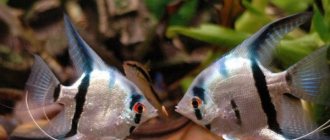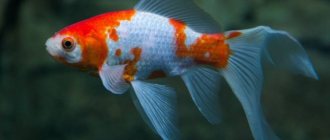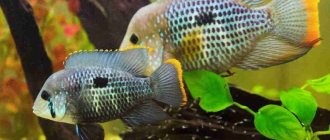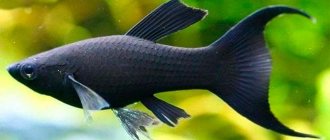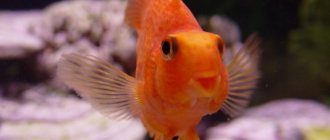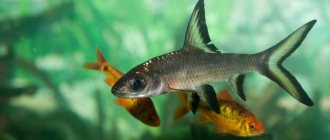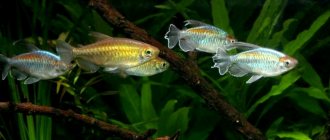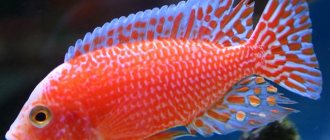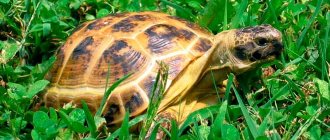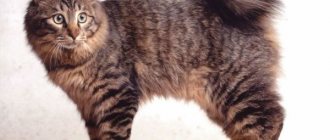Habitat in nature
The fish lives in fresh waters, mainly in the lakes of Malawi. Among all the places, the fish chooses rocks or shallows where it can profit from larvae. Mature males are very brightly colored, which is why they attract aquarists from all over the world. That is why today there are breeding representatives of fish in the aquarium that are able to mate with each other. Breeding aulonocara has made it possible to obtain new color variations, for example, aulonocara mailanda black.
Appearance
Aulonocara has a body typical of cichlids - elongated and slightly flattened on the sides, the head is pointed, the jaw is pronounced, and the eyes are large. According to aquarists, the sensory organs are small depressions on the head. Sense organs help fish find food among the sand. According to the description, females have transverse stripes on their bodies that are weakly pronounced, and in Maylandi they are completely difficult to distinguish. The fins of the fish are well developed and have a colorful border. Males have bright yellow or orange spots on their anal fin, which females do not have.
Character
By nature, the fish are relatively peaceful. Females do not cause problems, but males can be aggressive during the spawning period, protecting their territory. Pisces are distinguished by their intelligence; they get used to their owner and recognize him. If they don't like the way the stones are positioned, the aulonocars will definitely move them in their own way.
Lifespan
In order for a fish to live long, it needs to create optimal conditions. On average, different types of aulonocara live about six years, but with good care they live about 8 years.
Compatibility with other fish
Despite its calm nature, it is best to place Aulonocara in a species aquarium with cichlids. This is where residents feel most comfortable. Aulonocara looks very beautiful with blue dolphin, hummingbird cichlid, pterygoplicht, ancistrus.
Behavior and Compatibility
Aulonocaras are distinguished by high intelligence, the ability to get used to the owner and recognize him. They love to dig in the ground and rearrange stones to suit their taste, so the aquarist sometimes has to work hard to keep the aquarium not only clean, but also beautiful.
Aulonocaras, ready to reproduce, occupy a hole, cave or depression, and become aggressive towards their neighbors. If there are a large number of individuals, there should also be enough minks so as not to provoke fights for territory.
Intraspecific compatibility is allowed: aulonocara of different characters get along well with each other in sufficient quantities. Some fish are more aggressive, others, on the contrary, are calm and peaceful. If there is enough shelter in the aquarium, fish with different personalities will coexist successfully. It is better to stock cichlids at the same time so that they grow together. The team may not accept a newcomer.
Neighbors may include catfish (pterygoplichts, ancistrus) and other Malawian cichlids of similar size. The average size of an adult aulonocara is 13-15 cm.
Kinds
There are various types of aulonocara with interesting, “talking” names, for example, aulonocara strawberry. Let's look at the brightest representatives.
Aulonocara orchid
Aulonocara orchids are distinguished by their bright red color, which is why they are sometimes called strawberry aulonocara. The body of Aulonocara orchid red has mother-of-pearl inclusions, giving the representative a visual uniqueness. Aulonocara orchid, the strawberry, has thin stripes and spots on the dorsal fin. Photos of Aulonocara orchids on special sites are some of the most attractive.
Multicolor
Multicolor has a variety of colors. This is the most popular type. The body of Aulonocara multicolor has a yellow tint with beautiful iridescent black spots, and the fins are blue-blue. Aulonocara multicolor also has black spots on its fins.
Nyasa blue
Nyasa differs from other representatives in its pronounced color; it is not for nothing that she was nicknamed aulonokara queen nyasa. The body is blue, in males there is a transition to a yellow tint. The blue color can also change shade depending on the light and the condition of the fish; when afraid, the stripes turn pale. Aulonocara nyasa may also have purple scales.
Bensha
Aulonocara benshi is a fish with a predominant lemon tint on the body. Blue spots are scattered throughout the benshi's body, mainly in the abdomen. The bensha has light-colored transverse stripes on its body. Aulonocara bensha looks very beautiful with blue fish.
Aulonocara Red flash
The red flash fish has a blue body color, but its stripes are not dark, but mostly turn into pink of varying saturation. The pectoral fins of Aulonocara red flush are distinctly blue in color, with needles at their ends. The dorsal fin of Aulonocara red flash has the former border.
Aulonocara Aurica
Aulonocara aurica is distinguished by a pronounced yellow tint of the body in front, turning into blue towards the tail. The fins are blue, there are blotches of black on the body. Hybrid forms have a greater variety of shades.
Aulonocara Rose
Aulonocara rose has a completely soft pink body, even the fins are transparent and also colored pink. Translucent fins are decorated with pink spots. The fish looks great with bright neighbors.
Aulonocara Red ruby
Aulonocara red ruby has a predominantly red tint to its scales. Occasionally, blue transitions in the shade are visible; the dorsal fin of the red ruby has a beautiful white edging.
Aulonocara Red Dragon
Aulonocara red dragon is a hybrid species, the body has a predominantly delicate pink color with splashes of blue. The eyes are large and yellow. Fin with a beautiful white border.
Aulonokara Freiberg
Aulonocara freiberg is one of the largest fish. Outwardly similar to the red ruby, but the body is predominantly blue, only a small part towards the dorsal fin is red. The pelvic fins are also red.
General description of Aulonocara
Aulonocara multicolor (Aulonocara multicolor) belongs to the genus of cancers that live only in African waters. But this type of cichlid is the result of selection and is not found in nature. The color of the fish is variegated: there are blue-blue spots on the yellow-orange body. Males, like all representatives of Acaridae, are much brighter than their partners. Females have a body with a grayish tint, which makes it very difficult for novice aquarists to distinguish them from other representatives of the Cichlovidae.
Multicolor aquarium fish can reach a length of up to 15 cm, but its size depends on the conditions of detention. Cichlids have an oval body, flattened laterally, and a large pointed fin on the back.
If all the necessary conditions are created for Aulonocara, it can live in a home aquarium for up to 8 years.
Maintenance and care
Keeping and caring for fish is not difficult if you do everything correctly and in a timely manner. Purchase equipment according to the volume of the aquarium, high-quality filters, and also thoroughly clean the aquarium, change the water weekly.
Water parameters
Water for comfortable keeping of fish should have the following parameters:
acidity – 7.6-8.6 units;
hardness – 12-25 units;
temperature – 24-29 degrees.
Lighting
Lighting plays a key role when visualizing fish. They look beautiful with soft diffused light, but lamps with special shades can also be used.
Vegetation
Plants are of no value to aulonocara - they will easily dig up the most beautiful algae, and it will die. It is best to bury greens with a good root system in the ground, for example, Cryptocoryne, Vallisneria, Echinodorus. For decoration, you can put driftwood or stones.
What to feed
Aulonocara is a fish accustomed to larvae, so it is best to choose animal food as a diet, and it should make up at least 80% of the total volume. The rest is plant food. You should not give live food to aulonocaras; in an aquarium, the fish gets by with high-quality dry food, for example, Tetra Cichlid in granules.
Live food can cause illness.
For brighter color, you can use Tetra Cichlid Color, Tetra Rubin Granules, and TetraPro Algae is suitable as a plant substitute.
You do not need to feed often, since aulonocaras in an aquarium are prone to overeating; you can go on a hunger strike once a week.
Feeding multicolor
Food for this type of fish can be varied. It is important to alternate between dry and live food.
Aulonocara multicolor can be fed:
- special flakes or granules;
- fresh or frozen brine shrimp;
- Cyclops;
- coretra;
- bloodworms in small quantities.
When feeding aulonocara, it is important to alternate dry and live food
. In order for the fish’s body to have more red tints, you can feed food that contains a large amount of carotenoids:
- Gamarus;
- spirulina;
- saffron;
- paprika.
You can also prepare the food yourself. To do this, you will need raw squid meat (you can add mussels and shrimp), which must be ground, nettle and lettuce leaves, spinach, saffron (they will need to be scalded). To the resulting mixture you need to add calendula petals, pumpkin or zucchini.
It is important not to overfeed the fish, so it is recommended to feed it no more than twice a day. It is also necessary to alternate feed for Aulonocara.
Breeding and reproduction
Reproduction is possible from one year of age. Often the process itself begins in the aquarium, so you need to carefully monitor the female. Aulonocara is characterized by the formation of temporary pairs, exclusively for the reproduction of offspring.
To spawn, the male digs a hole in the ground, and the female lays eggs there, after which she swallows them and carries the eggs in her mouth. She will be fasting during this time. This is how the female protects the eggs from danger from other inhabitants.
How to determine gender
Determining the sex of the Aulonocara fish is not difficult. The females have an unremarkable color, but the males clearly stand out. Upon reaching sexual maturity, their color becomes brighter, and bright yellow or orange spots appear in the anal fin area.
Aquarium
These fish require a spacious aquarium of at least 80 liters for a pair of fish, the optimal volume for a group is 150-400 liters.
Fine sand, the fraction of which is no more than 2 mm, is used as soil. The thickness of the soil and the bottom area should allow the fish to establish spawning grounds. It is necessary to have shelters made of stones, grottoes and caves in which young individuals and females can hide.
Water parameters
Temperature: 24 - 28° C; pH: 6.0 - 9.0; Hardness: 12-25° DH.
It is important to constantly monitor the preservation of high optical qualities of the water and prevent siltation of the soil, since even small doses of ammonia are dangerous for fish. The aquarium requires constant aeration and filtration.
Description and natural habitat
Aulonocara or African acar are tropical freshwater fish. They form a whole world, numbering 21 species and dozens of different morphs. There are a larger number of representatives known that have not yet been scientifically described. They were named according to their color or where they were caught. They will probably be classified and renamed later.
The birthplace of the species is the ancient rift lake Malawi (Nyasa) in eastern Africa, according to some sources, a remnant of prehistoric seas. Aulonocaras prefer sandbanks or underwater rocks, where there is an opportunity to hide or find food (insects, larvae). They can live at great depths, where there is little light, but their bright colors help them notice each other.
The body is elongated, with a high back and a large, angular head, on which there are clearly visible depressions. These are supposed to be sense organs.
Photo gallery of Aulonokara:
Females and juveniles are inconspicuous, gray in color with black spots and stripes. The difference is in the males, which as they grow become blue or blue with a steel tint. In addition, some areas are painted in lemon and cherry shades, which is why they are called “peacock cichlid” - “peacock cichlids”. Hybrids with pink, blue, azure and black colors were bred. The formation of the external appearance ends by 2 years. The fins are also bright. Can be yellow, sea green or blue. The long dorsal fin has a light edge, and the back fin has golden or red spots. The length is 8-20 cm.
Aulonocara is a schooling fish that feeds mainly on insects and larvae found on the bottom. That's why she stays close to him. But about 20% of its food is plant-based; it is an omnivorous, peaceful species. This is an egg-laying species; almost all females have the ability to carry eggs in their mouths. Pairs are created temporary for the duration of spawning.
Diseases and prevention
Many diseases are caused by poor living conditions and poor quality food. If the environmental parameters do not meet the necessary ones, then immunity decreases and the fish becomes susceptible to various infections that surround it.
At the first suspicion of a disease, be sure to check the water, its composition and the concentration of nitrogen products. Having restored normal conditions, the fish return to normal, but sometimes treatment with special drugs may be required. Then broad-spectrum antibiotics are used until the signs of the disease completely disappear.
Poor quality feed can cause the disease Malawi Bloat. It is characterized by a rapid progression with a fatal outcome. External signs: loss of appetite, sluggish movement, bulging eyes and difficulty breathing.
The causes may be different, but they must be considered in their entirety. It is best to comply with all requirements for keeping fish in an aquarium.
Origin of fish
Experts believe that the ancestors of this hybrid are predatory fish from Lake Malawi, which is located in eastern Africa. They feel great at a decent depth and in complete darkness. In a sense, these fish are unique because when hunting insects and their larvae, they freeze at a certain distance from the bottom of the reservoir in anticipation of food. As soon as any insect appears in the field of view, the fish swallow it along with the soil. After this, they absorb food and filter particles of soil through their gills.
All species of Aulonocar differ in body size and color, but the conditions of keeping and feeding are the same for all.
